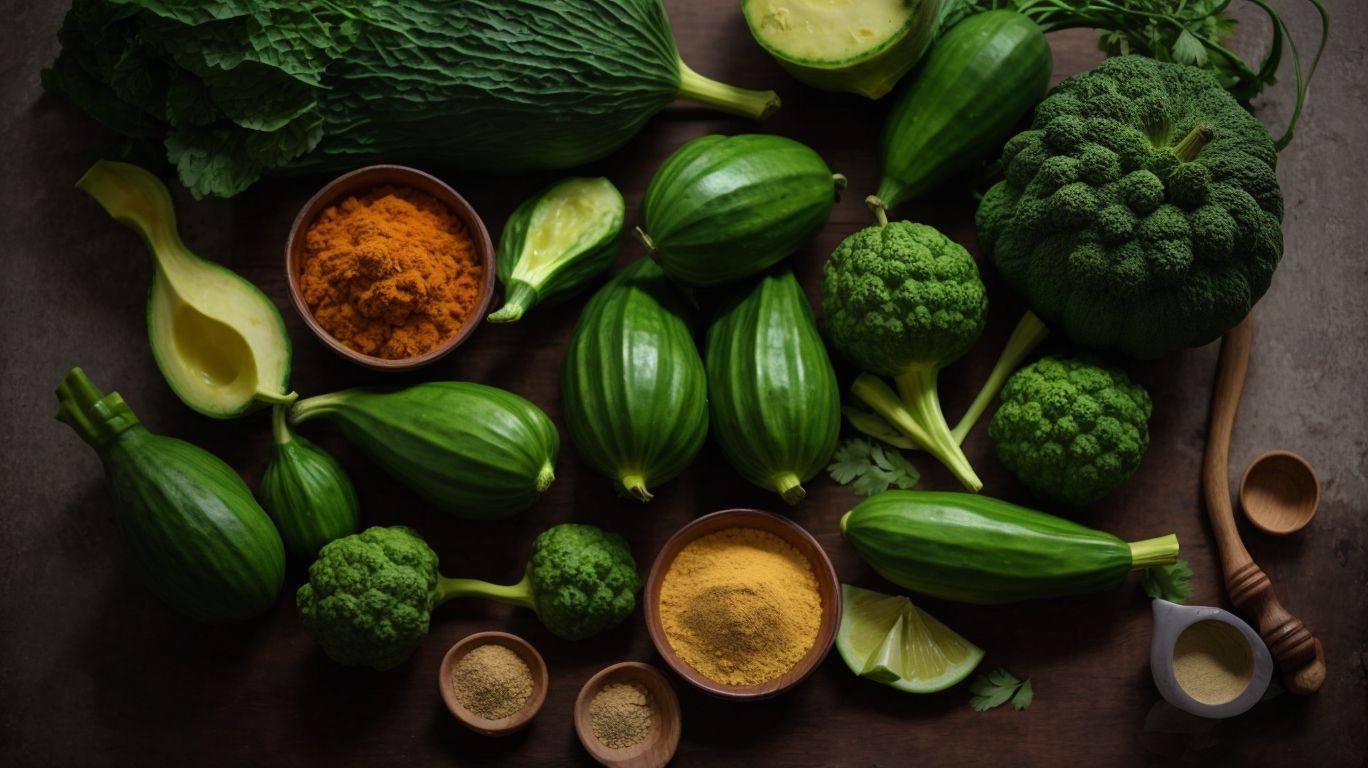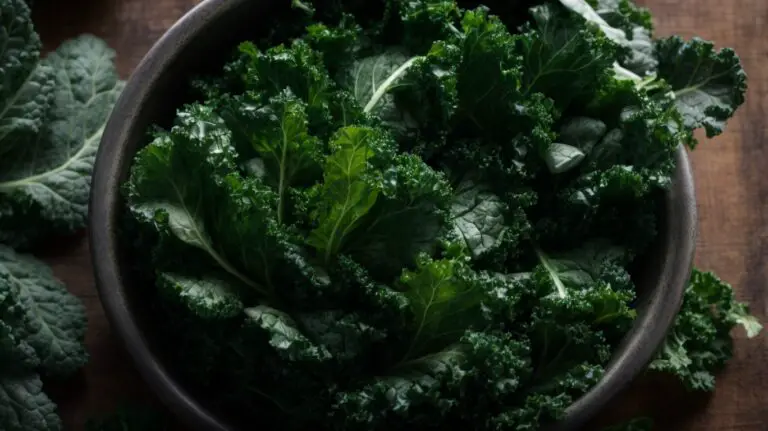How to Cook Karela Without Bitterness?
Are you a fan of Karela but can’t stand its bitter taste?
In this article, we will explore everything you need to know about Karela – from why it’s bitter to how you can reduce its bitterness.
Discover some handy tips and delicious recipes that will make you fall in love with this nutritious vegetable all over again. Let’s dive in and uncover the secrets to cooking Karela without bitterness!
Key Takeaways:
What is Karela?

Credits: Poormet.Com – Christian Allen
Karela, also known as bitter gourd, is a vegetable that belongs to the cucurbitaceous family.
Known for its distinct bitter taste, Karela is commonly used in various culinary dishes around the world. Despite its unique flavor profile, Karela is highly nutritious, packed with essential vitamins and minerals like Vitamin C and iron.
In Indian cuisine, Karela is often used in recipes such as Karela Sabzi, a stir-fried dish, or Bharwa Karela, stuffed bitter gourd. Its bitterness is balanced with spices, onions, and other ingredients, creating a flavorful and wholesome dish.
Karela is believed to have medicinal properties and is used in traditional medicine to help regulate blood sugar levels and improve digestion.
Why is Karela Bitter?
The bitterness of Karela is primarily due to the presence of compounds known as cucurbitacins.
Cucurbitacins are natural plant compounds found in bitter-tasting vegetables like bitter melon, zucchini, and cucumbers. They act as a natural defense mechanism to protect the plants from pests and predators. In Karela, these compounds not only contribute to its characteristic bitterness but also offer numerous health benefits. Studies have shown that cucurbitacins possess anti-inflammatory, antioxidant, and potential anti-cancer properties, making Karela a valuable addition to a healthy diet.
How to Reduce the Bitterness of Karela?
Reducing the bitterness of Karela can be achieved through various methods such as marinating with yogurt, soaking in salt water, or using vinegar.
Marinating Karela is a common technique used to enhance its flavor while reducing bitterness. The acidity of yogurt helps to tenderize the vegetable and neutralize the bitter taste. To marinate Karela effectively, slice the vegetable thinly and coat it evenly with yogurt mixed with spices of your choice.
Soaking Karela in salt water is another effective way to reduce its bitterness. The salt helps draw out some of the bitter compounds, making the vegetable milder in taste. Simply submerge the sliced Karela in a bowl of salt water for about 30 minutes before rinsing thoroughly.
Using vinegar in your Karela recipes can also work wonders in diminishing the bitter flavor. The acidity of vinegar helps to balance out the bitterness, resulting in a more palatable dish. Consider adding a splash of vinegar to your stir-fries or curries containing Karela for a tangy twist.
Soaking in Salt Water
Soaking Karela in salt water is a traditional method used to reduce its bitterness and enhance its taste.
When preparing Karela using this technique, start by washing the Karela thoroughly and then cutting it into slices or cubes as per your recipe requirements. Next, place the chopped pieces in a bowl of water with a generous amount of salt. Let the Karela soak for at least 30 minutes to an hour. This process helps to draw out the bitter compounds, making the vegetable more palatable.
To further enhance the flavor, you can also add a pinch of turmeric or a squeeze of lemon juice to the salt water solution. After soaking, rinse the Karela pieces with fresh water to remove excess salt before incorporating them into your dishes.
Using Tamarind Paste
Adding tamarind paste to Karela can help balance out the bitterness with its tangy flavor.
By incorporating tamarind paste into dishes featuring Karela, you not only mitigate the bitterness but also introduce a delightful contrast of flavors. The tanginess of tamarind not only masks the overpowering bitterness of Karela but also adds a refreshing zing to the overall dish. Tamarind paste can be used in various forms, such as a marinade, a tangy sauce, or even as a dressing. Its distinctive sweet-sour taste can elevate the flavor profile of Karela dishes, making them more palatable and enjoyable for a wider audience.
Marinating with Yogurt
Marinating Karela with yogurt not only reduces its bitterness but also adds a creamy texture to the dish.
This method is particularly effective in neutralizing the strong bitterness of Karela, making it more palatable for those who may not be accustomed to its taste. The lactic acid in yogurt helps to tenderize the vegetable and break down some of the bitter compounds, resulting in a milder flavor profile. The yogurt imparts a tangy and slightly sour note that balances out the natural bitterness of the Karela. This marination process also allows the flavors to meld together, enhancing the overall taste of the dish.
Sprinkling with Sugar
Sprinkling sugar over Karela can help mask its bitterness by adding a touch of sweetness to the dish.
This technique is particularly useful when cooking with bitter gourds, as their strong bitter taste can be overwhelming to some palates. The addition of sugar not only balances out the flavors but also enhances the overall taste of the dish. When using sugar to reduce bitterness in Karela, it’s essential to remember that a little goes a long way. Too much sugar can overpower the natural flavors of the vegetable, so start with a small amount and adjust according to your taste preference. Opt for a balance of sweet and bitter flavors to create a harmonious dish that is both delicious and nutritious.
Blanching in Hot Water
Blanching Karela in hot water before cooking can help soften its bitterness and make it more palatable.
“
Blanching is a simple yet effective technique that involves briefly immersing the Karela in boiling water and then immediately cooling it in ice water to halt the cooking process. The hot water helps to draw out some of the bitter compounds present in the Karela, resulting in a milder flavor profile. By using hot water, you can retain more of the vegetable’s nutrients compared to boiling or steaming it for an extended period.
For optimal results, it is recommended to blanch Karela for about 2-3 minutes, depending on the size and thickness of the slices. Be cautious not to over-blanch as it may lead to loss of texture and nutrients. This brief blanching duration strikes a balance between reducing bitterness and preserving the vegetable’s natural goodness.”
Using Vinegar or Lemon Juice
The acidity of vinegar or lemon juice can help counteract the bitterness of Karela, resulting in a more balanced flavor.
When using vinegar or lemon juice to reduce the bitterness of Karela, it’s crucial to understand the role of acidity in flavor modulation.
Acidity works by enhancing other flavors, masking bitterness, and bringing a refreshing tang to dishes. To incorporate these ingredients effectively, try marinating Karela slices in a mixture of vinegar or lemon juice along with complementary spices before cooking. The acidity will help tenderize the vegetable and infuse it with a zesty kick, transforming the bitter taste into a delightful balance of flavors.
What Are Some Tips for Cooking Karela Without Bitterness?
When cooking Karela to minimize its bitterness, consider tips such as choosing young and tender Karela and cooking it with complementary flavors like onions and potatoes.
Another useful tip is to soak sliced Karela in salted water for about 30 minutes before cooking to reduce its bitterness. You can also sprinkle a little salt on the sliced Karela and let it sit for a while before rinsing it off to further lessen the bitterness.
Experiment with adding ingredients like tangy tomatoes, aromatic spices like cumin and coriander, and a touch of sweetness from jaggery or honey to balance the flavors of Karela. Sautéing the Karela with these ingredients can help in masking the bitterness.
For a different twist, consider pairing Karela with ingredients like bell peppers, chickpeas, or even a creamy coconut milk-based gravy to elevate its taste profile and make it more appealing to those who are not big fans of bitter flavors.
Choose Young and Tender Karela
Opting for young and tender Karela varieties can help reduce bitterness and improve the overall texture of the dish.
When selecting Karela, keep an eye out for smaller sizes with firm skin, as these are indicators of youthful produce that will be less bitter. Avoid larger Karela with tough, wrinkled skin, as they tend to have more mature seeds and a stronger bitter taste.
Remember that younger Karela have a milder flavor and a more delicate texture, making them ideal for dishes where bitterness needs to be balanced with other flavors. It’s best to choose Karela that are bright green and firm to the touch, indicating freshness.
Remove the Seeds and Pith
Removing the seeds and pith from Karela can significantly decrease its bitterness and improve its culinary appeal.
One effective technique for scraping Karela is to first wash the vegetable thoroughly to minimize any residual bitterness on the surface. Then, using a sharp knife, gently slice the Karela vertically into two halves. Be cautious while scraping to avoid damaging the flesh. Remove the seeds and pith with a spoon or a sharp-edged spoon, ensuring to extract as much of the white membrane as possible.
Slice Karela Thinly
Slicing Karela thinly before cooking can help distribute flavors evenly and reduce the intensity of its bitterness.
The provided text is already well-formatted with HTML tags for bold formatting and paragraph breaks. No further changes are necessary.
Cook with Other Flavors and Spices
Enhancing Karela dishes with a variety of flavors and spices can help mask the bitterness and create a balanced taste profile.
In terms of cooking Karela, the key lies in the art of blending different flavors and spices to elevate the dish to a whole new level. By incorporating diverse spices, you not only enhance the taste but also add depth and complexity to the final dish.
Pairing the bitterness of Karela with tangy flavors like lemon or tamarind can help cut through the bitterness and bring a refreshing twist to the dish. Spices like cumin, coriander, and garam masala can add warmth and richness, balancing out the overall flavor profile.
To reduce the bitterness of Karela, consider techniques such as soaking in saltwater or marinating with yogurt and spices before cooking. These methods can help mellow out the harsh bitterness and make the dish more palatable. Remember, experimenting with various flavor combinations and spices is the key to unlocking the true potential of Karela in your cooking.
Use the Right Cooking Method
Choosing the right cooking method, such as deep frying or stir-frying, can impact the bitterness level of Karela while preserving its nutritional benefits.
When deep frying Karela, the high temperature helps in reducing the bitter taste by caramelizing the sugars present in the vegetable. While this method may not be the healthiest due to the use of oil, it can provide a delicious crunch.
On the other hand, stir-frying Karela in a hot pan with minimal oil retains more of its nutritional content compared to deep frying. The quick cooking time helps maintain the vegetable’s vitamins and minerals.
To strike a balance between reducing bitterness and preserving nutrients, steaming Karela is a recommended method. Steaming helps soften the vegetable without losing its valuable vitamins and minerals.
What Are Some Delicious Karela Recipes Without Bitterness?
Prepare flavorful Karela dishes that are free from bitterness by exploring recipes such as Karela Chips, Stir-Fry, Curry, Salad, and Soup.
If you want to introduce Karela to children, try making Crunchy Karela Chips that resemble potato chips. Simply slice the Karela thinly, remove the seeds, toss them in olive oil, salt, and your favorite spices, and then bake until crispy. Kids love the crunch and flavor without the usual bitterness!
- For a quick and nutritious meal, whip up a simple Karela Stir-Fry by sautéing sliced Karela with colorful bell peppers, onions, and garlic. The savory flavors will delight even the pickiest eaters.
- Transform the traditional Karela Curry into a creamy delight by adding coconut milk or yogurt during cooking. The creaminess balances out the slight bitterness of the Karela while adding a rich flavor.
- Karela Salad is a refreshing dish that pairs well with grilled meats or as a light lunch option. Combine thinly sliced Karela with cucumber, tomatoes, mint, and a tangy dressing for a vibrant and healthy salad.
- Turn Karela into a comforting meal with a hearty Karela Soup. Simmer sliced Karela with tomatoes, onions, and spices until tender, then blend until smooth for a velvety soup that even vegetable skeptics will enjoy.
Karela Chips
Karela Chips offer a delightful snack option that combines the crunch of chips with the nutritional benefits of bitter gourd.
When preparing Karela Chips, it’s essential to start by ensuring the bitter gourd slices are thinly cut to achieve a crispy texture. To reduce the bitterness, soaking the slices in salted water for about half an hour and then patting them dry can be helpful. Once the bitterness is reduced, coat the slices with a mixture of gram flour, rice flour, and a pinch of turmeric for added flavor and color.
In terms of deep-frying the chips, make sure the oil is hot enough to avoid them becoming soggy. Fry in small batches to maintain the oil temperature and ensure even cooking. Consider incorporating spices like cumin, chili powder, or even chaat masala in the coating for a burst of flavors.
For a visually appealing presentation, serve the Karela Chips on a platter garnished with fresh cilantro or mint leaves. A side of tangy yogurt dip or spicy chutney can complement the flavors of the chips perfectly. Enjoy these crunchy, flavorful bites as a snack or as a unique side dish to elevate your meal.
Karela Stir-Fry
Karela Stir-Fry is a quick and flavorful dish that pairs the unique taste of bitter gourd with a medley of spices and vegetables.
To enhance the flavor profile of your Karela Stir-Fry, consider adding a combination of cumin seeds, turmeric, coriander powder, and a dash of red chili powder. These spices not only complement the bitterness of the gourd but also add depth and warmth to the dish.
For vegetable inclusions, you can add diced onions, sliced tomatoes, chopped green chilies, and even some bell peppers for a colorful and nutritious touch. These vegetables create a harmonious blend with the bitter gourd, balancing out the flavors and textures.
When cooking Karela Stir-Fry, ensure that you slice the bitter gourd thinly and soak it in salted water for about 15-20 minutes to reduce its bitterness. After draining and rinsing the gourd, sauté it with the spices and vegetables on high heat to achieve a delicious caramelized finish.
Karela Curry
Karela Curry is a popular dish in Indian cuisine, known for its rich flavors and aromatic spices that complement the bitterness of the gourd.
For those looking to recreate this authentic dish at home, start by slicing the karela (bitter gourd) into thin rounds and soaking them in salted water to reduce the bitterness.
Once the bitterness is reduced, heat oil in a pan and add cumin seeds to infuse a nutty flavor into the dish. Follow this by adding finely chopped onions, ginger, and garlic to create a fragrant base.
Next, add a blend of traditional Indian spices such as coriander powder, turmeric, cumin powder, and garam masala to elevate the flavors.
Simmer the curry until the karela is tender, and garnish with fresh cilantro before serving hot with steamed rice or roti for a satisfying meal.
Karela Salad
Karela Salad offers a refreshing and nutritious option, combining the goodness of bitter gourd with a medley of fresh vegetables and tangy dressings.
If you are looking to prepare this vibrant salad, start by thinly slicing the karela and soaking it in saltwater to reduce its bitterness. Then, chop up colorful bell peppers, juicy tomatoes, crunchy cucumbers, and zesty onions for a variety of textures and flavors. For the dressing, you can experiment with a mix of lemon juice, olive oil, honey, and a hint of mustard, or opt for a light vinaigrette. To enhance the presentation, consider topping the salad with toasted nuts, feta cheese, or fresh herbs. This salad not only looks visually appealing but also packs a punch in terms of nutrition, making it a dynamic addition to your meal lineup.
Karela Soup
Karela Soup is a comforting and nourishing dish that transforms the bitterness of the gourd into a velvety and flavorful soup option.
To make a delicious Karela Soup, start by gathering all your ingredients – fresh bitter gourd (karela), tomatoes, onions, ginger, garlic, and a mix of spices like turmeric, cumin, and coriander powder.
Enhance the flavor of the soup by adding a hint of tanginess with lemon juice or tamarind paste. You can also balance the bitterness of the karela by incorporating a natural sweetener like honey or jaggery.
For a thicker texture, consider blending half of the soup mixture and then combining it back with the remaining chunky soup. This creates a creamy consistency without using any cream or dairy products.
In terms of garnishing, fresh cilantro leaves, a dollop of yogurt, or a sprinkle of roasted cumin seeds can elevate the presentation and taste of your Karela Soup.
Frequently Asked Questions
How to Cook Karela Without Bitterness?
1. What is the best way to remove the bitterness from Karela?
Soaking the Karela in salt water for 30 minutes before cooking is an effective way to remove some of the bitterness. You can also try sprinkling salt on the Karela and letting it sit for a few minutes before rinsing it off.
Can you suggest any alternative methods to remove the bitterness from Karela?
2. Can I use any other ingredients or techniques to reduce the bitterness of Karela?
Yes, you can try marinating the Karela with yogurt or lemon juice for 15-20 minutes before cooking. Another method is to stuff the Karela with a mixture of spices, such as cumin and coriander, to balance out the bitterness.
Is there a specific type of Karela that is less bitter?
3. Which variety of Karela is known to have a milder taste?
The Indian variety of Karela, known as “Karela Nu Shaak” or “Bharwan Karela” is less bitter compared to other varieties. This variety is commonly found in Indian grocery stores.
Can I cook Karela without any bitterness at all?
4. Is it possible to completely eliminate the bitterness from Karela?
While it may not be possible to completely remove the bitterness from Karela, using the right ingredients and techniques can help reduce it significantly.
Are there any tips to prevent Karela from becoming bitter while cooking?
5. How can I ensure that the Karela does not become too bitter while cooking?
Make sure to remove the seeds and the white membrane inside the Karela, as they are the source of most of the bitterness. Also, do not overcook the Karela, as this can intensify its bitterness.
Can you recommend any recipes that use Karela without it being too bitter?
6. Do you have any delicious recipes that feature Karela without it being overwhelmingly bitter?
Yes, you can try recipes like Karela Chips, Karela Sabzi, or Karela Chutney, where the bitterness is balanced out with other ingredients and spices. These recipes can be found on my blog, Poormet.com.




